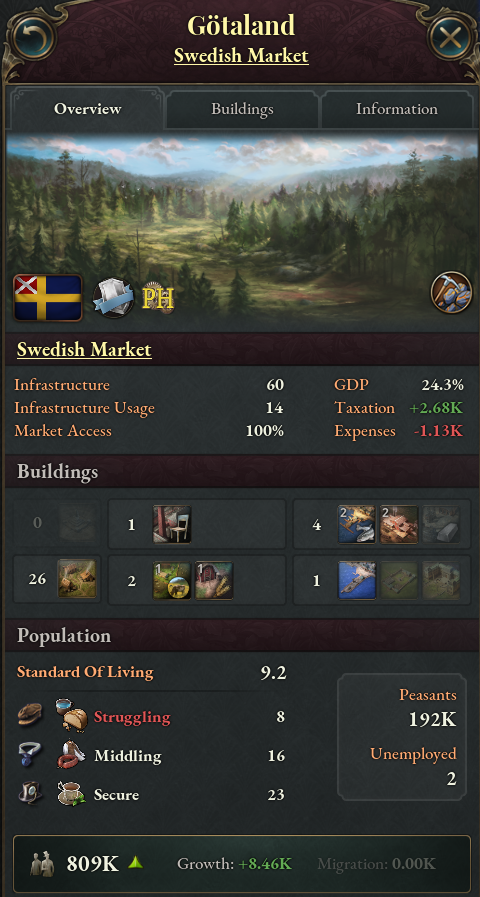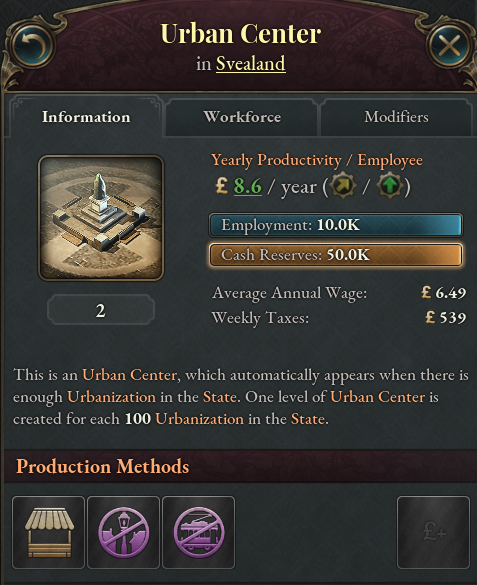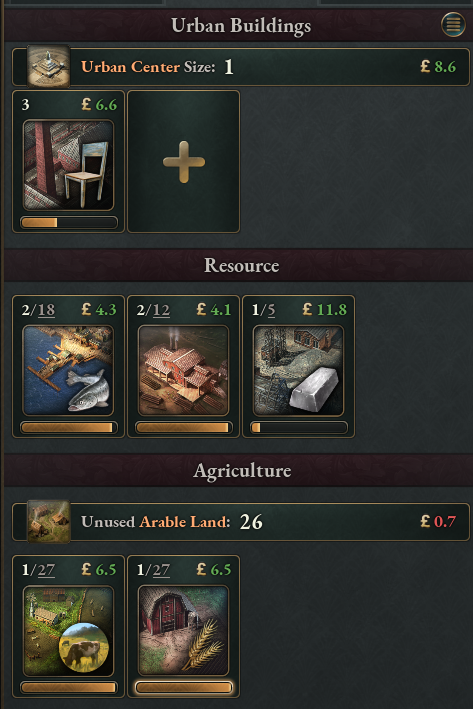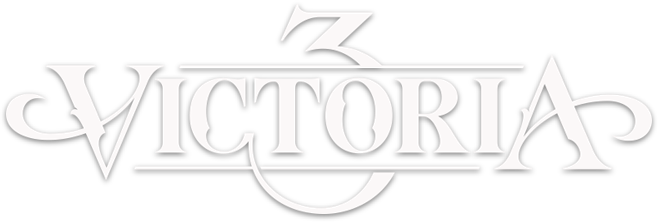This comment will be used over the next few days to collate developer responses for ease of reading.
really like the change to require pops for ports and railroads!
Looks pretty promising. Will there be cosmetic difference between buildings of different cultures/regions? And do building show up on the map (based on the preview images showing cities in your provinces?)
We're not ready to discuss the map yet but we will definitely have a lot to share there in the future.
Presumably they turn the extra 10 money into dividends, which is a thing.
That is correct, as the Cash Reserves fill up more and more profits will be withdrawn as dividends.
Hey! Dev Diary! Looks cool, I like that bureaucrats use stationary to do their work. Can't count taxes with your fingers!
I've got a question though: what happens when the cash reserves max out? Like if a factory is putting 10 pounds a week into its reserves what happens to those 10 pounds every week when the reserves are topped up? Thanks!
If cash reserves are full, that money is paid out in dividends instead.
Did I read it right that I could create a Megalopolis in Southern sweden with 1000s of Pops and numerous factories?
I'm going to be a very authocratic figure to resettle and keep my pops in Megalopolis but otherwise there doesn't seem to be a limit?
There may be sort of a 'practical limit' in the sense that you can't cram 5 million people onto St. Helena but it should certainly be possible to have huge cities anywhere there's enough land, infrastructure and jobs.
All of this seems good, but I wonder how crops like coffee are going to be limited or if you are going to be able to grow coffee in Great Britan
Which crops can be grown depends on the state, so coffee should only be able to be grown in places where it was either grown or plausibly would have been grown in the span of the era.
While I think this is a reasonable way to represent subsistence farming early game, is there any way to improve the effectiveness of such buildings, or are they fated to forever be the VIc3 equivalent of clerks? I'm thinking mainly about how one might represent the traditionalist/conservative programs to modernize but maintain the peasant way of life in Eastern Europe and Asia.
You can improve your agriculture by building farms and plantations (think enclosure systems and industrial agriculture as opposed to tiny subsistence farms).
I know this development visions will not change, but a realy strong point in victoria 2 was the private sector being independent from the government (player) with the laissez faire policy.
The Government deciding to produce lumber has sense in planned economy, not in laissez faire.
I suppose is easier to let the player micromanage the production that coding a better AI.
Honestly, while AI is of course a challenge the main reason for this is that which buildings are built in your country is so fundamental to the both the economic gameplay and society building aspect of Victoria 3 that we don't think it makes sense to not let the player interact with it. We don't want the game to play itself, so to speak.
Do subsistence farms have a product? If not, who's paying the peasants?
Yes, subsistence farms produce a small surplus, most of Peasants' labor is self-sustaining though so they're only marginally integrated into the wider economy.
So a single RGO per province as a concept is dead? That's wonderful, seems way more flexible in a realistic manner. I notice though that I can only see three types of resource buildings based on the icons - fishing docks, lumber mills and iron mines I think - is that because those are the only thing available in that province? Would icons for coal mines, sulphur mines, rubber plantations, tropical wood, etc. show up in the appropriate areas as well? Or are the shown handful of options meant to encompass many different types of resources? Such as the lumber mill being able to output tropical wood if it's in the right place, or the mine outputting coal if that's the resource around it?
Also, I understand the player should ultimately be the national gardener here, but if the player chooses to give investors the freedom of a much looser economy policy I would love to seem them get the freedom to do their own thing, scaling that autonomy up with increasingly liberal policies! It's part of the risk-reward of liberalizing in my opinion - the risk of bad investments on the part of investors, but the reward of an economy that can self-sustain and even reach critical mass without full player micromanagement. Obviously this would only work if the AI worked better than prior Victoria games' AI, but I believe!
Yeah, you can have numerous different mines, plantations, etc as potentials that you can exploit in the same state. As long as you have the people to work it and the infrastructure to support it, of course.
how quickly do buildings fill up with workers? If I build an iron mine will it take months to employ the workers or will it be instant? Also is the bar under each building employment?
It depends on how many pops you have that are qualified for the jobs, whether those pops are willing to take the salary offered, etc. It's possible for instance for a mine to remain largely unproductive because there's almost nobody qualified to be an engineer in the state.
This is one of my biggest fears.
I hope it works in a organic and gradual way.
A building should lose and gain workers every month, not just use workers as if they were a stable manpower pool, workers should give this Vic2 organic feeling that they have their personal and individual circumstances.
I don't want to see "you click a button and you get an instant benefit" mechanics like EU4 has.
While buildings aren't just going to randomly shed workers, Pops are not obliged to take jobs and can leave a building to take a higher paying job elsewhere (which is one of the ways you can actually have standard of living go up in a state, as buildings hike wages to compete for labor).
The thing is, some people puts the player as the government, so the player building all the factories and stuff is incompatible with more liberal forms of government.
However, I think the devs are putting the player as the country itself, its society, etc. So theres no incompatibility with the player building factories because the player isnt the government itself but a embodiement of the country and its society.
Yep, you don't play as the government, you play as the 'spirit of the country'. It's hardly the only example of the player being able to do something that would be outside the purview or against the interest of the government in one of our games. That said, we've not completely set our mind on the investment pool as it works now and are discussing other ways we could do it.
Does this include areas where it could have been grown but for whatever reason wasn't until later? I'm thinking primarily of coffee in places like Kenya and Uganda, which in terms of climate could have been grown during this time period or even earlier, but for various other reasons did not spread to the region on a commercial scale until the mid 20th century outside the game's time frame.
Yes, with the caveat that it's not as simple as 'if the climate allows it' since then half the world would be covered in opium potentials. We try to strike a balance between climate, farming traditions and what feels like it could have been a potential grow site during the Victorian era.
This is probably hoping for too much detail, but will the agriculture system model agronomy at all? Will monoculture crop plantations lose yield over time? Will fertilizers appear eventually as a way to improve yields?
We do not currently have any system for losing yields over time, but the use of fertilizer is for sure a big deal in making your agriculture more efficient in Victoria 3.
One thing that I'm still not able to understand is what is the GDP % in the state screen (I know what is GDP). Usually GDP is expressed in absolute economic value. Does it refer to annual growth? (24% increase is HUGE.) Does it refer to the proportion of that state over the country? (if this, I guess it can be useful and less abstract than an absolute number in pounds, but it will be constantly varying up/down depending on the expansion of your country and may be misleading -- the state GDP is growing but its regional % is decreasing because you are adding new states)
Also, cheers to all the devs. Don't let the pressure from all the forum doomers to derail your plans. Wouldn't like to be in your place, though!
The state's contribution to national GDP.
One interesting thought I had with bureaucrats now consuming paper. Since the game runs up to the 1930s, it would be interesting to have a late game tech for very early computerization that would begin to reduce the amount of paper consumed per bureaucracy but make government administration start requiring maybe electric gear or telephones/radios.
I like this idea and may in fact end up stealing it.
Will I be able to see this as a foreign nation?
Could be very useful strategic wise to know occupying which state would hurt my opponent most
Yes we don't hide any information when inspecting other nations States

If the player has total control of the country's economy regardless of economic policies
This is for sure not the case! The country's different economic systems enable and prohibit both certain pop behaviors and actions the player can take, in addition to making it easier or harder to engage in certain playstyles. So both a set of hard locks/unlocks on actions and modifiers/cost adjustments. We'll get into more details on this in the near future.
Like
@Wizzington has hinted at a few times already in this thread, a crucial bit of design intent behind our approach to never prohibit the player from engaging in new construction, or put construction wholly on AI autoplay, is that choosing which aspects of your country to invest into and expand - represented by different buildings - is the
core of Victoria 3, informed both by economic and political concerns. Expanding an Iron Mine in a newly conquered unincorporated part of your country can have very different long-term knock-on effects from expanding one in your capital, and predicting or discovering these kinds of effects in retrospect is a big aspect of our enjoyment when playing. We don't want the player's choice of economic system to either make the game unplayable because of micromanagement requirements nor remove the society-building aspect from the experience.
To put this a different way, we want the decision to switch to a different economic system to be based on a play strategy that develops in response to the game. For example, the Industrialists (or the United States) might demand you open your market and you decide you're not in a good position to fight them, or perhaps you welcome the opportunity. This demands each system be a valid choice in its own right, without forcing the player into a kind of game they don't like playing. We never want to force the player to make a decision about which direction to take their country because the alternative is boring or impossible to manage.
But that for sure doesn't mean it should feel the same to play a Laissez-Faire country as one with a Command Economy.
This is shaping up nicely - the implementation on buildings sounds like a vast improvement from RGOs in Victoria 2.
Looking at the first screenshot (The State of Götaland), there are quite a few different units on show that I'm not sure I'm understanding.
Infrastructure has a value of 60 (out of 100?), with usage at 14. Does this mean the state has a theoretical maximum infra value of 60, and it is currently developed to 14, or that it is currently developed to 60, and only 14 units are currently being used by the market?
GDP is shown as 24.3% - does this mean almost one quarter of Sweden's current GDP is in this state, that the state is currently developed to almost one quarter of the theoretical maximum, or that growth is running at 24.3%? (which of course seems very unlikely).
Turning to population, the standard of living is given as 9.2 (an average across all PoPs I assume). How do we interpret this, is 9.2 out of 10, or 100? 8 units are struggling, 16 middling and 23 secure - what do these numbers represent? They do not sum to 100%, to the 9.2 total living standard, or to the 809k population for the state.
Of the 809k population, 192k are peasants (which sounds quite low, depending on the date), and '2' are unemployed. Is this literally 2 people, 2% or 2 units?
Great feedback, our UX designers are on the case

Regarding Peasants, those are just the Workforce part of the equation, so in fact the vast majority of the total population are of the Peasant class. The intent is to show how much potential workforce you have available in the state, but side-by-side that is indeed very confusing and will also be addressed. Just wanted to clarify that the population are not actually made up of only 1/4 Peasants in 1836 Götaland!
This comment is meant as a convivence for those whom are only interested in reading the Devs responses to questions. You can access this functionality yourself at any time by clicking on the "
Show only dev responses" button located at the top of any post.
















